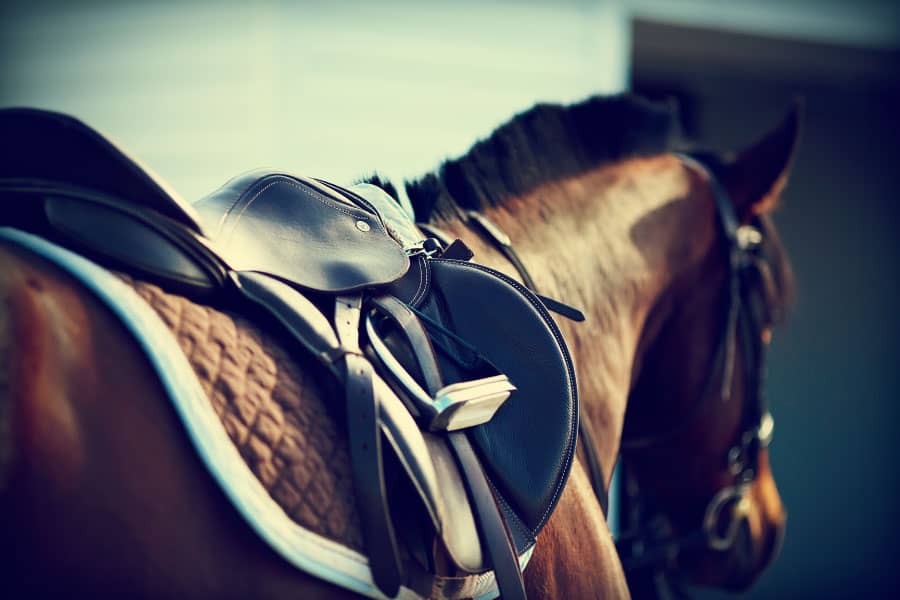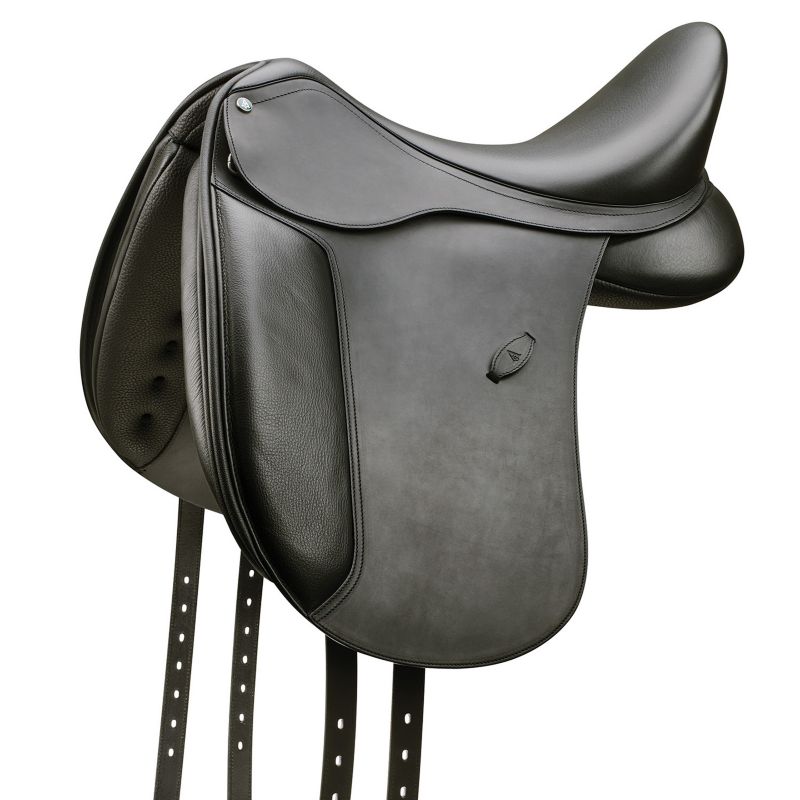- Your source for stall mats, rubber arena footing, arena harrows and arena dust control.

A dressage saddle has unique characteristics that make it easily identifiable and very different to ride in. One can immediately feel the difference in your body posture and your horse when you go from a general-purpose or jumping saddle to a dressage saddle.
Using a Dressage saddle that is fitted to your horse will make a big difference for your riding and for your horse. A Dressage saddle is designed to help the rider and horse perform to the best of their ability in the dressage ring. Other saddles may hinder your or your horse’s Dressage capabilities.
In this article, I will go into more details about dressage saddles, compare dressage saddles to other saddles, and explain how a dressage saddle makes a difference.
A brief history of Dressage
Firstly, let’s go into a quick history of dressage and dressage saddles. Dressage is a french term that means to “train.” According to the FEI, dressage is described as: “the highest expression of horse training, where the horse and rider are expected to perform a series of predetermined movements from memory.”
Dressage has a lot of meanings to a lot of different people. It is used to train horses and is considered to baseline for all other disciplines. Dressage consists of the training side of horses and the competition side that tests our ability in training.
In 680BC, equestrian sports were introduced into the Ancient Olympic Games in Greece. Around 350BC, the well known greek horseman Xenophon developed his training method for horses and wrote the book “On horsemanship.”
His training methods were sympathetic and systematic. In 1532, Neapolitan nobleman Federico Grisone opened the first riding school that taught Dressage in Italy. In 1594, Antoine de Pluvinel opened his own horse riding academy called “Academie d’Equitation” in France to teach noblemen, and followed in Xenophon’s footsteps, using a more humane and kind way of training horses.
In 1658 the concept of Dressage was born in Britain after William Cavandish published a book called “A General System of Horsemanship” in exile. The Spanish riding school, one of the most well-known riding schools in the world, opened in Vienna in 1735.
This led to the first Dressage competition being held in Pressburg in 1873, many years after the Spanish riding school opened. In 1912 Dressage made its first appearance in the Olympic Games in Stockholm, Sweden, and in 1921 the FEI was founded in Lausanne, Switzerland.
From then, Dressage as a sport grew exponentially throughout the years into the modern Dressage as we know it today, with its roots and basic principles from Xenophon’s time still being used today.
A brief history of the characteristics of the Dressage saddle
Let’s now look at the Dressage saddle, and it’s history.
A Dressage saddle has the following common characteristics:
- Long and straight flaps
- Deep seat
- High cantle
- Big knee rolls
- Long girth billets
- Short girth
- The stirrup bars are set further back
In the 18th Century, Dressage riders used a wooden frame saddle with a high pommel and cantel. This deepened the seat of the rider. These saddles were used for hunting, bullfighting, long-distance riding, and mounted combat as well. These saddles are still used today in the Spanish Riding school. The military saddles were open, flat, and plain to match their uncomplicated and plain bridles.
Later, when Dressage became more popular, and three-day eventing also increased in popularity, diversification of English saddles for the various disciplines also started.
The Dressage saddle continued to be upgraded but still staying within the classic shape, long flaps, long girth billets, set back stirrup bards, and a deep seat. The more extravagant looking saddles are because Dressage became part of civilian sport and not solely for Military soldiers. This led to the riders straying from the more plain-looking tack from the Military to more extravagant and “blinged” up tacked as we know today.
The types of breeds used in Dressage and the evolution of breeds of decades ago changed, which also led to a change in the shape and size of tack. The most prominent change is the widening of the space between the saddle panels: the gullet. This is to allow for more freedom of movement for the horse and thus more comfortable.
The materials used to make the trees, cover the saddle, and flock the saddle has changed into more durable and cost-effective materials.

Why does a dressage saddle make a difference?
Let’s look back at the characteristics and why these, compared to other saddles, make a difference for the rider and the horse competing in dressage.
For more on the differences between Dressage and Showjumping saddles, feel free to check out our article on “Can You Jump in a Dressage Saddle? “
“
Long and straight flaps
- The design is much different when compared to a Jumping saddle or Western Saddle, for example. Jumping saddle flaps are designed to provide for the rider with shorter stirrups by having shorter and rounder flaps. The jumping saddle keeps the rider’s leg under themselves with just enough movement to stand up in the stirrups and balance over jumps.
- A long and straight flap allows for the rider’s leg to be longer and straighter. This helps the rider to have as much leg contact on the horse as possible. The rider will find it easier to place their leg in the neutral position or further back or forward to give proper and clear aid to the horse. For example, to ask for a flying change, the rider needs to slide one leg forward (the side to which they want to change), and the opposite leg needs to slide back.
- The straighter flaps allow for more free movement of the horse’s shoulder under the rider. The scapula moved more easily, thus giving the horse more comfort, and thus they move better.
Deep seat
- The deep seat is designed for rider balance, comfort, and improvement of seat aids. The deep seat helps to hold the rider in place and limit the rider from moving and sliding around on the saddle too much, whereas a jumping saddle is more open and flat to allow the rider to move freely and stand up more easily over jumps.
- The deeper and more padded seat also provides more comfort for the rider, especially when riding bigger and more powerful horses when their movement becomes more extravagant or bouncier.
- With a deeper seat, the rider sits in the correct position to alter their seat slightly to aid the horse. The rider can shift their weight from one seat bone onto the next or lighten or deepen their seat.
Big knee rolls
- The larger knee rolls or knee blocks are designed to help keep the rider’s leg in the correct position and quiet when the leg is in the neutral position. It also provides for a more sturdy feeling in the saddle, helping the rider feel more confident.
Long girth billets
- The longer girth billets mean that the girth will attach lower than normal saddles’, and this allows for even more contact between the horse and the rider’s legs and allows less interference to the rider’s legs.
- The girth attaches at a point that is more comfortable for the horse as well.
The stirrup bars are set further back
- Hunting saddles have more forward set stirrup bars, along with showing saddles and jumping saddles. This allows the rider to have their legs straight forward in front of them to balance over obstacles or brace for landing.
- Dressage stirrup bars are set further back to allow the rider to comfortably hold their leg in the neutral position without the stirrups forcing the rider’s legs into a more forward position. This allows the rider to move their legs more easily.
Wide gullet and large panels
- This is a design characteristic for the comfort of the horse. The wider gullet allows for more movement of the horse’s spine and less pressure on the spinal ligaments on each side of the spinous processes. The large panels distribute the rider’s weight over a larger area, decreasing the pressure points and improving the comfort of a horse.
- A comfortable horse is a happy horse, and a happy horse performs to the best of their abilities.
Our top 5 picks for Dressage saddles
Here is a list of our 5 favorite Dressage saddles:
Wintec Isybell with Horse and Rider Technology (HART)
The Wintec Isabell was designed by world famous rider Isabell Werth, this saddle is designed for horse and rider comfort as well as effective riding. The synthetic seat allows fir extra grip and minimal sliding. The flaps, knee blocks and adjustable stirrup bars allow for a close leg contact to the horse and makes it easy for the riders leg to slide into the neutral position. The saddle allows for correct seat posture and ultimate balance. The panels are soft and mold to the horses back and conformation.
PDS Carl Hester Valegro Saddle
Who does not want to feel like the celebrity Carl Hester while riding the ultimate dream horse Valegro? Feel like a professional rider with the PDR Carl Hester saddle that features a plushy snd comfortable seat, well-designed tree, anatomical knee rolls for the perfect leg fit snd position, and thought outplaced billets for comfortable girthing for your horse.
Henri de Rivel monoflap Dressage saddle
This saddle is beautiful, elegant and comfortable. This saddle features gripping leather that provides the rider with just enough friction to prevent sliding and a super deep seat for ultimate position, balance and effortless riding. The saddle has a monoflap, which means that there is less between you and your horse, this provides for close contact and easy leg aids. The durability of the saddle is outstanding with its quality leather and stitching.

Bates CAIR dressage saddle
The bates cair saddles are elegant and designed for comfort and performance. The leather saddle seat has a narrower waist and a wide seat to allow for optimal comfort and a good position. The cair cushion system is two air pockets in the panels of the saddle that provides a soft and dynamic panel that is comfortable for your horse. The knee rolls are molded to fit the riders legs comfortably.

Arena Dressage saddle with HART
The Arena dressage saddle features Horse and Rider Technology to ensure optimal style, comfort and ride ability. This saddle is designed with the horse in mind with their cair panels and ergonomic flex trees. The knee blocks are moveable which enables the rider to find the perfect and most comfortable fit.

Conclusion
And there you have pretty much everything to know about why Dressage saddles actually make a difference.
I hope you enjoyed our brief history lesson as well and checked out the 5 picks for our favorite Dressage saddles.
Also, feel free to check out our article on “Is Dressage Harder Than Jumping? “
“



